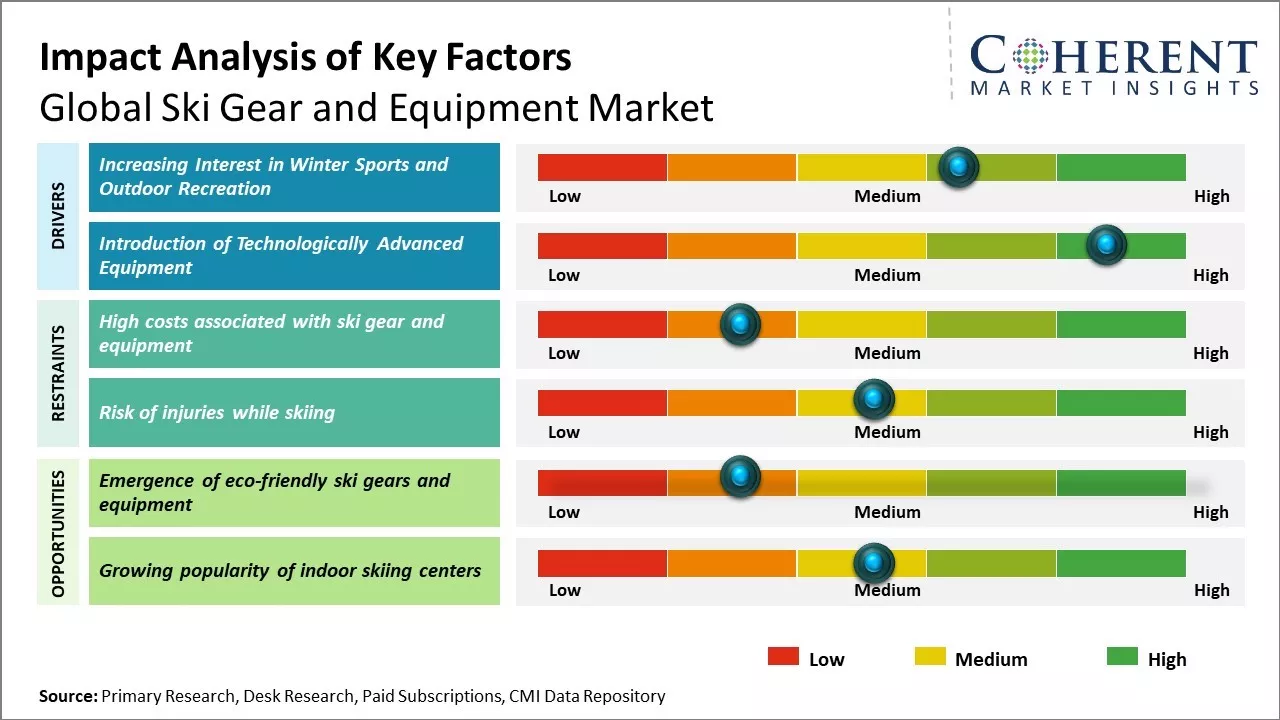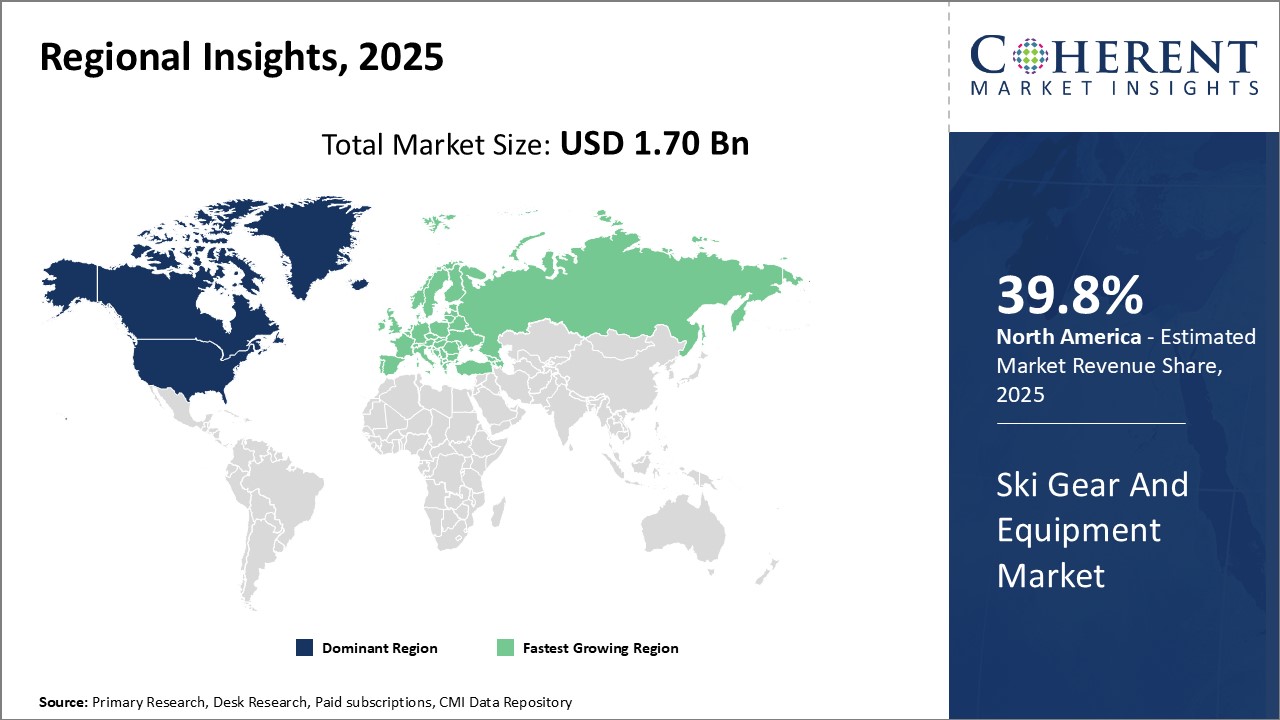The ski gear and equipment market is estimated to be valued at USD 1.70 Bn in 2025 and is expected to reach USD 2.09 Bn by 2032, exhibiting a compound annual growth rate (CAGR) of 3.0% from 2025 to 2032.

To learn more about this report, Download Free Sample
The market for ski gear and equipment has seen considerable expansion lately, primarily due to a growing enthusiasm for winter sports and outdoor recreational pursuits. Moreover, heading to the mountains in the winter has become a super popular way for people of all ages to have fun and relax. Because of this, millions of people are hitting the slopes every year. For example, the National Ski Areas Association reported that the number of skier visits in North America has jumped by over 15% in last five years.

To learn more about this report, Download Free Sample
|
Current Events |
Description and its impact |
|
Global Climate Change and Seasonal Variability |
|
|
Technological Innovations and Consumer Trends |
|
Uncover macros and micros vetted on 75+ parameters: Get instant access to report
Technological advancements are reshaping ski gear for winters. The smart features provide real-time snow and temperature data. Various designs that are adaptable like adjustable vents and photochromic lenses are arising. Versatility and durability are mainly used for less predictable seasons. Consumers seek gear for multiple activities. This brings in demand for specialized maintenance products and services.
Climate change is changing skier decisions on purchases and destinations. Reliable snow condition and resort status information are important for bookings and equipment buying. Resorts and shops face pressure for transparency and flexible options. A shift towards higher-altitude resorts may increase demand for cold-weather gear. On the other hand, shorter seasons may influence rentals and budget-friendly options. Brand sustainability and environmental efforts can influence consumer choices too.
The rising demand for environmentally sustainable products presents a major opportunity for ski gear and equipment manufacturers. More skiers and snowboarders, especially younger generations, are increasingly concerned about the environmental impact of their sport and want to choose equipment that reduces waste and carbon footprint. For instance, WNDR Alpine introduced Shepherd snowboard in 2023. The company is pioneering the innovative use of biotechnology, incorporating materials like the Algal Core and Algal Wall, which are derived from microalgae oil.
In terms of product type, clothing segment is expected to contribute 46.2% share of the market in 2025, owing to its dual role of protection and fashion.
As skiing and snowboarding require participation in cold weather conditions at high altitudes and speeds, clothing plays a crucial protective role by keeping participants warm and safe. The specialized fabrics, fits and styling of ski clothing allow freedom of movement on the slopes while shielding the body from snow, wind, and sub-freezing temperatures.
The protective benefits of technical clothing help increase participation in skiing and snowboarding activities, driving demand. In addition to functionality, ski clothing also appeals due to its fashionable qualities. Inspired by mountain lifestyle trends, brands infuse clothing with creativity in styling, designs, and colours that allow self-expression on the slopes.
In terms of application, the female segment is expected to contribute 37.3% share of the market in 2025, due to growth in inclusiveness and participation.
Traditionally male-dominated, winter sports are embracing greater gender diversity and catering to women's specific needs, fueling a rise in the female demographic. Varied programming, mentorship opportunities and women-only lessons lower initial intimidation barriers for newcomers. Equipment is also evolving with women's anatomies in mind. Tailored boots, thinner liners and shorter skis/boards fit female frames more precisely for balance and manoeuvrability.
In terms of distribution channel, supermarkets/hypermarkets segment is expected to contribute 39.3% market share in 2025, driven by mass access and convenience in product selection and purchasing.
As skiing and snowboarding gear needs change season to season for wear-and-tear repairs or new trends, one-stop shopping destinations fulfil the consumer demand. Supermarkets incorporate large sports departments stocked with equipment, clothing, and accessories from top brands year-round.
The convenient service model of supermarkets streamlines supply to high consumer demand volumes, justifying their lead market position over niche channels.

To learn more about this report, Download Free Sample
North America has been the dominant region in the global ski gear and equipment market. The region is expected to account for 39.8% of the market share in 2025. The presence of major ski gear manufacturers such as Columbia Sportswear, Spyder, K2 Sports, and Burton has made North America the manufacturing hub for ski products. The U.S. is a major exporter of high-quality ski apparels and accessories to European markets, and it also imports ski boots and snowboards from Canada. This active trade has enabled the North American ski industry to cater to diverse consumer demands. However, the region is facing intense competition from Chinese manufacturers who are providing cost-effective gear and equipment.
The ski gear market in the Asia Pacific region is experiencing rapid growth, outpacing all other regions in growth. Rising disposable incomes, growing interest in winter sports among the middle and upper classes, and increasing participation in skiing in countries like China, Japan, and South Korea drive the region’s growth. For instance, Japan saw a significant increase in inbound ski tourism during the 2024–2025 winter season, leading to a corresponding spike in demand for ski apparel, equipment, and accessories.
The Indian ski gear market is showing encouraging growth, driven by increased participation in winter sports and government support in the Himalayan region. Demand is visible as more Indian consumers engage in skiing internationally and domestically. Governmental initiatives promoting ski infrastructure and events like the Khelo India Winter Games, most recently in March 2025, are contributing to growing interest and equipment demand, making India as a market with notable potential for ski brands.
The integration of Artificial Intelligence (AI) into the Ski gear and equipment sector is transforming traditional approaches to designing and optimizing ski equipment.
Ski Gear And Equipment Market Report Coverage
| Report Coverage | Details | ||
|---|---|---|---|
| Base Year: | 2024 | Market Size in 2025: | USD 1.70 Bn |
| Historical Data for: | 2020 To 2024 | Forecast Period: | 2025 To 2032 |
| Forecast Period 2025 to 2032 CAGR: | 3.0% | 2032 Value Projection: | USD 2.09 Bn |
| Geographies covered: |
|
||
| Segments covered: |
|
||
| Companies covered: |
Amer Sports Oyj, Black Diamond Equipment, Ltd., Coalition Snow, Fischer Beteilgungsverwaltungs GmbH, Helly Hansen, Icelantic LLC, Marker Volkl (International) Sales GmbH, Skis Rassignol S.A., The Burton Corporation, Volcom LLC., Zai Sakai, Anta International Limited, Black Diamond Equipment, Ltd., Decathlon, and Vista Outdoor Inc. |
||
| Growth Drivers: |
|
||
| Restraints & Challenges: |
|
||
Uncover macros and micros vetted on 75+ parameters: Get instant access to report
*Definition: The ski gear and equipment market caters to winter sports enthusiasts who enjoy skiing and snowboarding. This market provides essential clothing, footwear, protective gear, and other equipment needed for skiing and snowboarding activities. Products include alpine ski boots, downhill skis, snowboards, ski poles, ski or snowboard helmets, ski goggles, ski gloves, ski jackets, ski pants, base layers, thermal underwear, and other ski apparel.
Share
Share
Missing comfort of reading report in your local language? Find your preferred language :
Transform your Strategy with Exclusive Trending Reports :
Frequently Asked Questions
Joining thousands of companies around the world committed to making the Excellent Business Solutions.
View All Our Clients